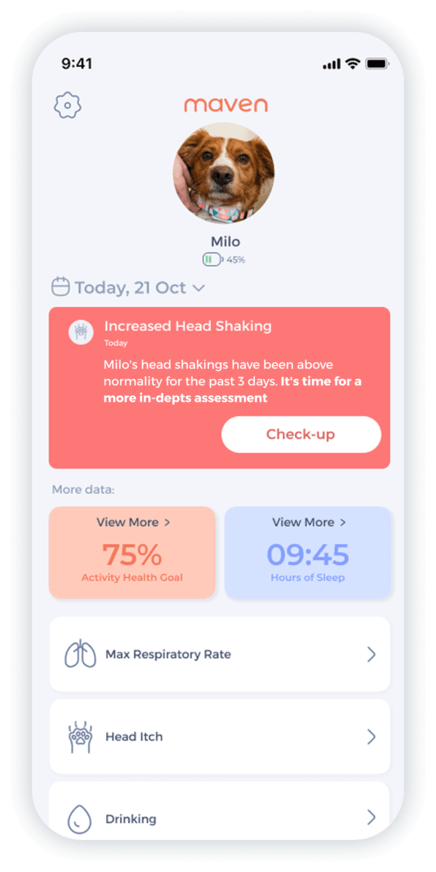Dog Heart 101: Questions and Answers (Vet Verified)
The heart is a vital organ, and one that raises many interesting questions. Just how differently does a dog heart work? We’re here to provide clear, vet-backed answers to these complex but common concerns.
Key Takeaways
- Heart Attacks are Rare: A dog heart attack caused by blocked coronary arteries is extremely uncommon. Dogs suffer more often from progressive heart disease leading to heart failure.
- CHF is Manageable: With early diagnosis and proper medication, dogs with Congestive Heart Failure can often live comfortably for many months to a few years.
- Early Monitoring is Key: Subtle changes in your dog’s resting respiratory rate, activity level, and rest quality are critical early warning signs of heart issues.
- Emotional Stress is Real: While a dog won’t technically die of a “broken heart”, severe grief can cause physical distress that worsens existing health problems.
- Use a Dog Health Tracker: Tracking heart rate and resting respiratory rate is essential to detect a heart condition as soon as possible, which can literally save your pet’s life.
Where Is a Dog’s Heart Located?

A dog’s heart is located in the thoracic cavity (chest), positioned between the ribs and protected by the ribcage.
It sits centrally in the chest but is slightly angled, with the apex (the pointed bottom) pointing toward the left side.
Do Dogs Have Heart Attacks?
The short answer is no, not in the same way humans do.
In humans, a heart attack is typically caused by a blockage in the coronary arteries, which is incredibly rare in dogs.
The most common severe heart issue in dogs is progressive heart disease leading to Congestive Heart Failure (CHF).
How Long Will Dogs Live with Congestive Heart Failure?
With adequate treatment, dogs with CHF often live between 6 months and 2 years.
But keep in mind that the prognosis for a dog diagnosed with Congestive Heart Failure varies depending on the cause, the stage of the disease, and the dog’s response to medication.
The timing of the diagnosis is extremely important. Dogs diagnosed in earlier stages who respond well to treatment have the longest survival times, sometimes exceeding the average.
“I got the Maven sensor for my 14-year-old Chihuahua mix with heart and trachea issues. It gave me back peace of mind – I can track her RRR, BPM, drinking, and activity anytime and know instantly if something’s wrong. Highly recommend!”

★★★★★
Chiara De Luca
Titti
How to Comfort a Dog with Congestive Heart Failure
Caring for a dog with CHF involves a blend of strict medical adherence and compassionate quality-of-life adjustments.
- Give all prescribed medications exactly as directed by your vet. Never skip or alter doses.
- Count your dog’s respiratory rate when they’re sleeping or completely relaxed. This is an essential step: if you detect rates above 30-35 breaths per minute, it may indicate fluid buildup, which requires immediate medical intervention. Using a pet health tracker here can be life-saving.
- Keep the environment calm and avoid over-excitement, which can strain your dog’s heart.
- Follow your vet’s recommendation for a low-sodium diet to help manage fluid retention.
- Opt for shorter, gentler walks instead of strenuous exercise.
- Provide extra snuggling and petting.
- Ensure their favorite resting spots are easily accessible without climbing stairs or jumping.
Will a Dog with Congestive Heart Failure Die Peacefully?
The main risk in advanced CHF is a sudden respiratory crisis (severe difficulty breathing) due to a rapid accumulation of fluid in the lungs.
This is not a peaceful experience and requires immediate vet intervention.
Because of this, many pet parents choose humane euthanasia when they observe that their dog’s bad days begin to outnumber their good days, or when their dog’s breathing difficulties worsen.
Euthanasia, when performed by a vet, is a controlled, pain-free process that allows our furry friends to pass away peacefully, surrounded by their loved ones.
How Do You Place a Pacemaker in a Dog’s Heart?
The placement of the pacemaker in a dog is generally performed by a veterinary cardiologist:
- It starts with placing the dog under general anesthesia.
- Then the vet makes a small incision, usually in the neck. The pacemaker lead (wire) is threaded through the jugular vein down into the right ventricle.
- The lead is connected to a small generator (the battery pack), which is then implanted just under the skin in the dog’s neck or sometimes the abdomen.
- The device is tested to ensure it’s regulating the heartbeat correctly. Post-procedure activity is strictly limited for several weeks to allow the lead to anchor firmly inside the heart.
Can Dogs Die of a Broken Heart?

The simple answer is no.
Dogs do not experience Takotsubo cardiomyopathy (the “broken heart syndrome” seen in humans, which causes temporary heart muscle weakening due to extreme stress).
However, it is a scientifically-backed fact that dogs experience profound grief and emotional distress when a companion pet or loved human dies. This distress can lead to significant physical decline:
- Severe anxiety and stress can lead to a loss of appetite, decreased water intake, lethargy, and a weakened immune system.
- In a dog with a pre-existing condition, such as heart disease or kidney disease, this physical decline and lack of self-care can be the catalyst that pushes them into a life-threatening crisis.
How Maven Pet Helps Track Heart Health and Early Warning Signs
“Heart disease in dogs can often be managed for years with the right care. Early detection and consistent monitoring truly make the biggest difference.” – Carolina Domingues, DVM, Veterinarian at Maven Pet
Heart disease is often a silent killer, with many dog parents not noticing symptoms until the disease is advanced. Because the most critical early sign of fluid build-up is an elevated resting respiratory rate, consistent home monitoring is vital.
The Maven Pet Health Tracker can be a game-changer for cardiac patients and at-risk breeds by providing data on key indicators:


Monitor heart rate, respiratory rate, activity & rest, drinking, itch behavior.
- Resting Respiratory Rate (RRR): Maven Pet provides a daily RRR baseline, flagging any sudden or consistent increase that could indicate fluid in the lungs, a sign of worsening CHF.
- Heart Rate: Tracking patterns in heart rate when your dog is at rest helps you and your vet catch irregular rhythms.
- Activity and Rest Changes: A sudden drop in activity or an increase in restlessness during rest can be subtle signs of lethargy or discomfort associated with heart progression.
Maven’s wearable connects with a pet health app, sharing clear, objective data with the vet. This allows you to move from subjective “they look tired” to “their RRR has been 38 breaths per minute for the last three nights,” prompting faster vet intervention.
Takeaways Recap
- The canine heart is a robust but vulnerable organ.
- While a true dog heart attack is rare, progressive heart disease is common, especially in certain breeds.
- The key to giving your dog the longest, happiest life possible is early detection and vigilant monitoring.
- By understanding the signs of CHF, following your vet’s treatment plan, and using a modern dog health tracker like Maven Pet to spot the subtle changes in RRR and behavior, you can ensure your furry friend receives the timely care they need.
Maven Pet focuses on improving the quality of life of our pets with technology, using artificial intelligence (AI) to enable proactive pet care. By accurately collecting and monitoring pet data 24/7 and flagging any irregularities, Maven Pet empowers pet parents and veterinarians to stay ahead of potential health issues, ensuring the well-being and longevity of our beloved companions.

